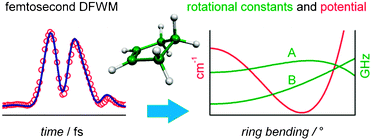Ring-puckering motion in cyclopentene studied by time-resolved rotational coherence spectroscopy and ab initio calculations
Abstract
The ring-puckering vibration in

- This article is part of the themed collection: Chemical Dynamics of Large Amplitude Motion

 Please wait while we load your content...
Please wait while we load your content...